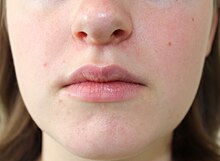| Perioral dermatitis | |
|---|---|
| Other names | Periorificial dermatitis |
 | |
| Papules around mouth and nostrils with some background redness and sparing of vermillion border | |
| Specialty | Dermatology |
| Symptoms | Papules, pustules, red skin |
| Complications | Skin infection |
| Causes | Unknown[1] |
| Risk factors | Topical steroids, cosmetics, moisturiser |
| Diagnostic method | Based on symptom and appearance |
| Differential diagnosis | Rosacea, acne |
| Treatment | None, tetracycline |
Perioral dermatitis, also known as periorificial dermatitis, is a common type of inflammatory skin rash.[2] Symptoms include multiple small (1–2 mm) bumps and blisters sometimes with background redness and scale, localized to the skin around the mouth and nostrils. Less commonly, the eyes and genitalia may be involved.[3] It can be persistent or recurring, and resembles particularly rosacea and to some extent acne and allergic dermatitis. The term "dermatitis" is a misnomer because this is not an eczematous process.[4]
The cause is unclear.[1] Topical steroids are associated with the condition and moisturizers and cosmetics may contribute.[4] The underlying mechanism may involve blockage of the skin surface followed by subsequent excessive growth of skin flora. Fluoridated toothpaste and some micro-organisms including Candida may also worsen the condition, but their roles in this condition are unclear.[5] It is considered a disease of the hair follicle with biopsy samples showing microscopic changes around the hair follicle. Diagnosis is based on symptoms.[5]
Treatment is typically by stopping topical steroids, changing cosmetics, and in more severe cases, taking tetracyclines by mouth.[1][6] Stopping steroids may initially worsen the rash. The condition is estimated to affect 0.5-1% of people a year in the developed world. Up to 90% of those affected are women between the ages of 16 and 45 years, though it also affects children and the elderly, and has an increasing incidence in men.[7][8]
- ^ a b c Cite error: The named reference
Tem_2014was invoked but never defined (see the help page). - ^ Lee GL, Zirwas MJ (July 2015). "Granulomatous Rosacea and Periorificial Dermatitis: Controversies and Review of Management and Treatment". Dermatologic Clinics. 33 (3): 447–55. doi:10.1016/j.det.2015.03.009. PMID 26143424.
- ^ Goldsmith LP, Katz SI, Gilchrest BA, Paller AS (2012). "Chapter 82: Perioral dermatitis". Fitzpatrick's Dermatology in General Medicine (8th ed.). The McGraw-Hill Companies. pp. 926–928. ISBN 978-0-07-166904-7.
- ^ a b Du Vivier A (2013). Atlas of clinical dermatology (4th ed.). Elsevier Saunders. pp. 609–610. ISBN 978-0-7020-3421-3.
- ^ a b Patterson JW (2019). "8. The granulomatous reaction pattern". Weedon's Skin Pathology (5th ed.). Elsevier Health Sciences. p. 219. ISBN 978-0-7020-7582-7.
- ^ Cite error: The named reference
Hall_2010was invoked but never defined (see the help page). - ^ Cite error: The named reference
Kammler_2020was invoked but never defined (see the help page). - ^ Habif TP (2009). "7. Acne, Rosacea, and Related Disorders". Clinical Dermatology (5th ed.). Mosby, Elsevier. pp. 253–255. ISBN 978-0-7234-3541-9.